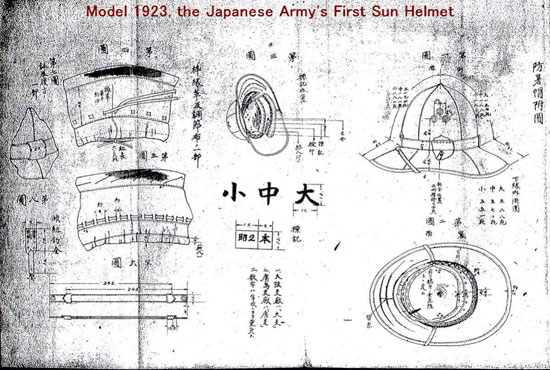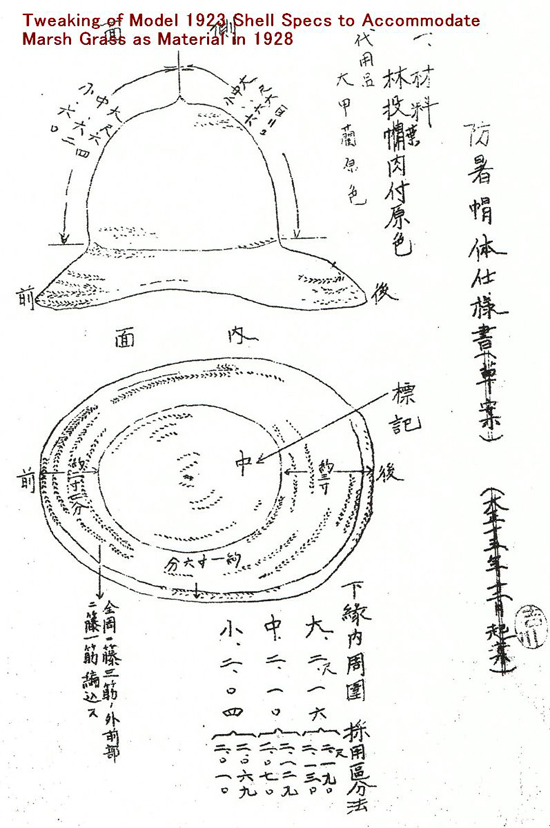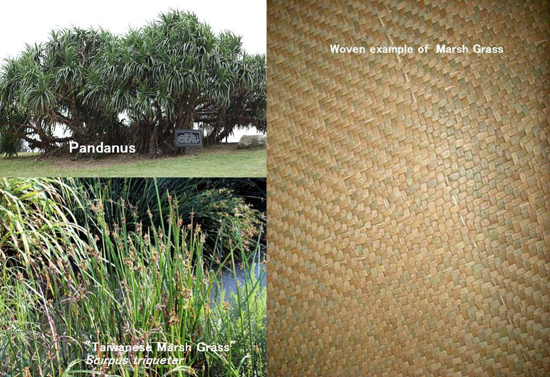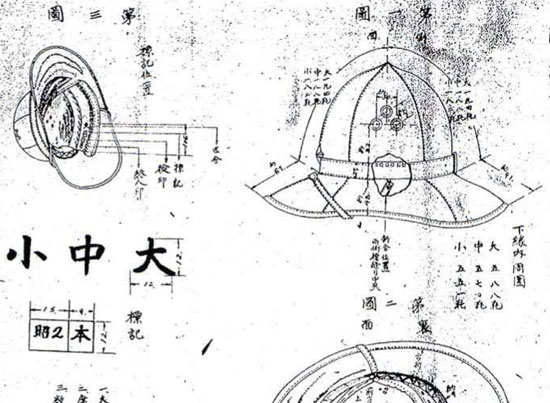This is a special study of Japanese tropical helmets by Nick Komiya, and is presented in four parts.
1921 Sun helmet Prototype testing
300 Sun Helmet Prototypes were produced for the test, of which 100 had “felt shells”, 150 had “woven Panama hat shells” and 50 had “Gourd Sponge shells (also tested in helmet covers later in 1934)”. These were benchmarked against the standard army visor cap and also against the captured German Sun Helmet.
Visor Cap vs German Sun Helmet
It was already known that the visor cap was no match for the heat-insulating performance of the captured German sun helmets, but for instance, when the ambient temperature was 38 degrees, the helmet was cooler by 5.
German Sun Helmet vs IJA Prototypes
The main improvement the IJA wanted to achieve over the German counterpart was dry weight as well as water drenched weight, which was achieved by all three prototypes by a comfortable margin.
Then in temperature comparisons throughout the day, the felt model bettered the German model. Beyond that point, it was a comparison between the 3 prototypes comparing impact of surface cloth colors, etc.
They tested white, sky blue, natural unstained cotton and the military green in both tropical Tainan and subtropical Taipei.
Sorry, but the data charts with temperature comparisons I originally put in here kept on falling out of alignment in the upload, so I had to remove them.

In summing up, they concluded that the Panama version was the most comfortable in heat. However, because it seemed to let through a lot of invisible sun radiation, they claimed to feel a stinging pain at the top of the head when the sun was high.
Felt came second in overall performance, but against blocking ultraviolet or infrared it was markedly better. Thus they said for Taiwan, “Panama” was the choice, but for more tropical climates, where invisible rays of a more intense sun could be expected to easily penetrate the panama shell, felt was thought to be a safer choice.
Gourd sponge was quickly eliminated when it got all soggy in rain and also gave off an unpleasant smell in that state.
In the latter part of the report it was revealed that what they referred to as “Panama” was actually a local Taiwanese Marsh Grass traditionally cultivated for weaving hats and baskets, and they further recommended Pandanus as also worth looking into, as they grew wild throughout the island in abundance which tended to produce a sharper looking product.
This suggestion was probably taken up later, because the first official sun helmet of the IJA that appeared two years later called for this Pandanus, which was not covered in the 1921 testing.
I only gave you the gist of the test results, but if you want more details, here is a spreadsheet summary from 1921 for you to study in detail.
1923 August, IJA’s First Model Sun Helmet Introduced (Model 1923)
The 1921 tests in Taiwan came to fruition in 1923, when the Army finally launched its official sun helmet design. There are no launch documents surviving, so it is not clear what the official designation of the sun helmet was at the time of its introduction, but judging by the lack of any Type designation even for the new steel helmet launched the previous year (star-vent/cherry blossom helmet), which was simply called a Provisional Standard “Kabuto” (head amour), I doubt that it got any designation like a Type 12 for the 12th year of Taisho (though the pistol that followed 2 years later became the Type 14).
Later army specification books, show spec revision histories, so even without launch documents, one can tell that the first specs were finalized on 3rd August 1923.
The drawing below is this first model IJA sun helmet, which I am likely unveiling for the first time in post-war history. This drawing must have been issued around 1927, judging by the sample markings, indicating the 2nd year of Showa, but spec revision history records confirm that no changes had taken place in between, so the 1923 helmet would have been identical to these drawings.

Also of note is that the drawing now calls the sun helmet officially a 防暑帽 (anti-heat hat), no longer a helmet hat. That word change probably occurred in the 1923 launch. Chances are it was officially called a Provisional standard anti-heat hat (仮制式防暑帽) in the 1923 launch in the same manner as the steel helmet.
Looking at the design, I cannot help being reminded of the “Man with the Yellow Hat” from the 1941 kid’s book, “Curious George” (“Coco – Der neugierige Affe” to Germans) and if this was supposed to be a refined design, one shudders to think what the “ridiculously ugly” first prototype from 1916-17 looked like.
Compared to the WW2 model familiar to many collectors, the liner system is much more conventional like the style the Germans used in WW2 with a zigzag spacer as insulation between the helmet shell and the sweat band. Apparent is the lack of any vents with cover at the top, but 3 large grommets on each side instead as ventilation holes. Also the helmet was made in 3 sizes of small, medium and large unlike the later one-size-fits-all design. The material finally selected for the woven shell was initially leaves from Pandanus tectorius, known in English as the Tahitian Screwpine.
1928 Jan. “Made in Taiwan”

The Army in Taiwan not only got to test the helmets, but was finally made to supply them as well. In the end, there is a sense of “tribal wisdom” in this making of tropical wear from locally available, time-tested native materials.
However, another tweaking was now necessary to make sun helmet production in Taiwan a truly viable proposition. This adjustment was the reason behind the spec revision dated “31st January 1928” in the spec revision history.
The army in Taiwan was required to supply 31,700 woven shells to the main depot by 15th February of that year, but material and labor availability was jeopardizing this order from the mainland.
The Pandanus (林投) leaves specified as material in the 1923 specs were not material available on any constant commercial basis, but something that the Taiwanese natives went out to collect when orders for sun helmets came in from the IJA. The plant was growing wild on the island and thus available in almost unlimited quantity, but processing of the leaves after harvesting involved extensive drying under the sun, which made such work in the rainy season impossible, because there were no indoor drying facilities.

On the other hand, what they had called “Panama” in the 1921 testing was actually what the natives favored for their own weaving. It was a plant called 大甲藺 (Tai Koui), a tall grass growing in marshland with the Latin name of Scirpus triqueter, (it has no English name, so I will call it Taiwanese Marsh Grass).
This grass was used traditionally to weave into hats in Taiwan and the local industry already had a capacity to produce 501,000 hats annually, supported by a commercially grown crop of the grass. They cultivated the grass by sowing seeds in January, which yielded two harvests in July and December.
Better yet, for this product, the island already was home to approx. 45,000 weavers, so if the sun helmet material could be switched to this grass instead of Pandanus leaves, immediate increase in production numbers could be achieved.
Pandanus was a much stiffer material to work with, so the existing labor force of grass weavers couldn’t be readily switched to work with the new material, unless given a period of adjustment for relearning the craft in the new material.
The Taiwanese marsh grass involved no disadvantages in weight or strength, and the only drawback of a tendency to grow mould, due to the humidifying needed before weaving, could easily be dealt with by drying the woven shells after completion.
Thus in January 1928, Taiwanese grass became accepted as an alternative shell material to Pandanus and slight changes to the specs were made to accommodate this alternative material.

